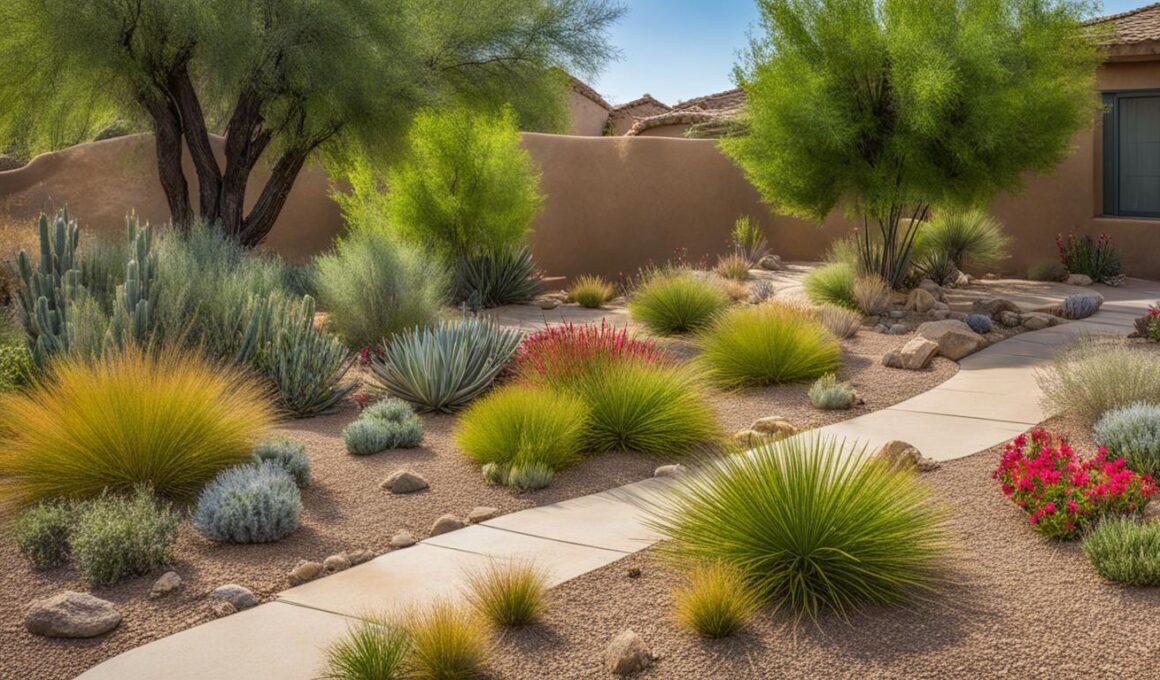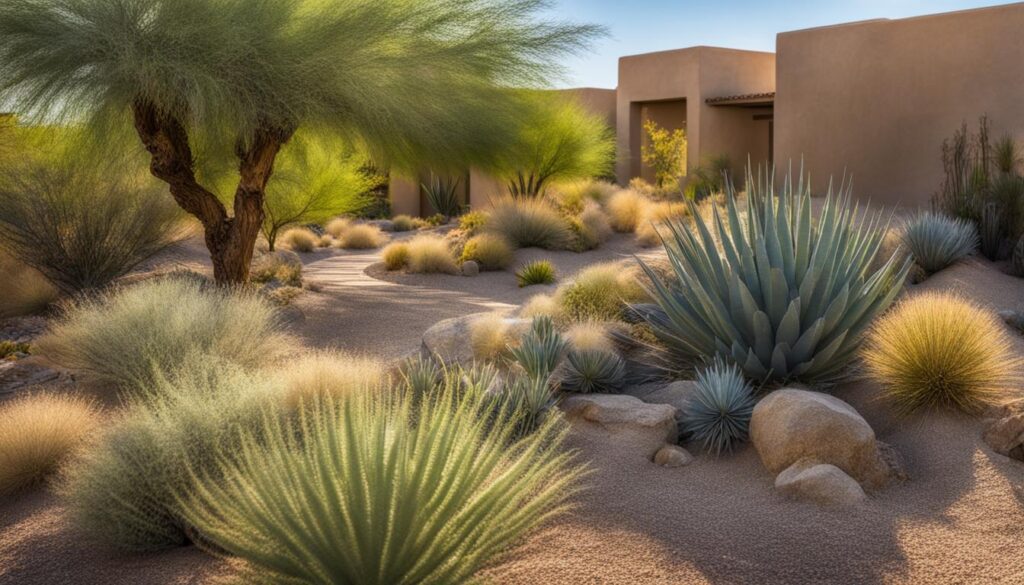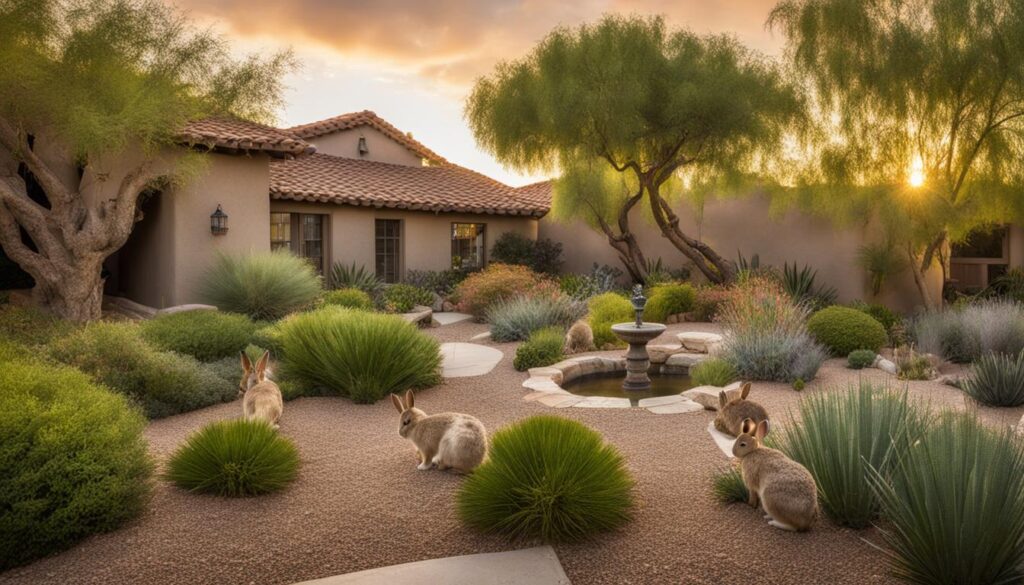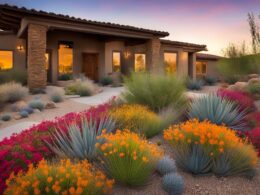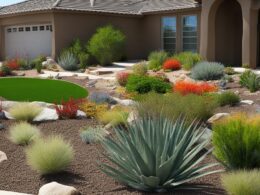Sustainable xeriscaping, with its focus on creating eco-friendly landscapes that support local wildlife habitats, has become increasingly popular. By incorporating conservation practices such as using native plant species, rain barrels, and xeriscaping techniques, you can create beautiful, low-maintenance outdoor spaces that provide food, green space, and shelter for local wildlife.
With the decline in natural habitats and the threat to local wildlife, it’s important to take action and contribute to the conservation efforts. Sustainable xeriscaping not only benefits wildlife, but it also helps to conserve water and reduce maintenance costs. By embracing this approach, you can create a harmonious environment that supports both the local ecosystem and your own enjoyment of your outdoor space.
In this article, we will explore the key principles and benefits of sustainable xeriscaping. We will also discuss how incorporating xeriscaping into master-planned communities can contribute to water conservation, environmental stewardship, and cost savings. So, let’s dive in and master the art of sustainable xeriscaping for wildlife habitats!
Key Takeaways:
- Sustainable xeriscaping creates eco-friendly landscapes that support local wildlife habitats.
- Native plant species, rain barrels, and xeriscaping techniques contribute to conservation efforts.
- Sustainable xeriscaping conserves water and reduces maintenance costs.
- Incorporating xeriscaping into master-planned communities promotes water conservation, environmental stewardship, and cost savings.
- Mastering sustainable xeriscaping techniques positions professionals for success in the industry and contributes to building a more sustainable future.
Benefits of Sustainable Landscaping for Wildlife
When it comes to sustainable landscaping, the benefits for wildlife conservation are significant. By incorporating eco-friendly practices into your outdoor spaces, you can create habitats that support biodiversity and promote the well-being of local wildlife.
One of the key advantages of sustainable landscaping is water conservation. By using native, drought-tolerant plants, you can significantly reduce water usage. This not only helps to conserve water resources but also minimizes the impact on local ecosystems. Additionally, sustainable landscaping practices such as mulching and water-efficient irrigation systems help to further optimize water usage, ensuring that it is effectively utilized by the plants and not wasted.
“Sustainable landscaping promotes biodiversity by creating diverse habitats that provide essential food and shelter for wildlife.”
Another important benefit is the promotion of biodiversity. Sustainable landscaping creates diverse habitats with a variety of plant types and textures. This attracts a wide range of wildlife, from birds and butterflies to beneficial insects. By providing essential food sources, shelter, and nesting sites, your sustainable landscape can contribute to the conservation and preservation of local wildlife populations.
Furthermore, sustainable landscaping can lead to significant cost savings for homeowners and property owners. By reducing water usage, maintenance costs, and the need for chemical fertilizers and pesticides, you can save money in the long run. Additionally, sustainable landscapes are often low-maintenance, requiring less time and effort to upkeep, further reducing costs.
Key Principles of Sustainable Xeriscaping
Sustainable xeriscaping follows key principles to create water-smart and environmentally friendly outdoor spaces. By integrating these principles into your landscaping projects, you can contribute to the preservation of natural resources and create landscapes that are both beautiful and sustainable.
Select Native Plants
One of the fundamental principles of sustainable xeriscaping is the selection of native plants. Native plants are well-suited to the local climate and require less water and maintenance compared to non-native species. By choosing plants that are adapted to the natural conditions of your area, you can reduce water usage and create a habitat that supports local wildlife.
Improve Soil Health
The health of your soil plays a crucial role in the success of your xeriscaping efforts. By adding organic matter such as compost or mulch to your soil, you can improve its water-holding capacity and nutrient retention. This not only helps your plants thrive but also reduces the need for additional water and fertilizers.
Implement Water-Efficient Irrigation Systems
Water-efficient irrigation systems are essential for sustainable xeriscaping. Drip irrigation and smart controllers are effective methods for delivering water directly to the root zones of plants, minimizing water waste. These systems ensure that plants receive the necessary moisture while conserving water and reducing your water bill.
Utilize Mulching and Hydrozoning
Mulching is another important practice in sustainable xeriscaping. By applying a layer of organic mulch around your plants, you can reduce evaporation, suppress weed growth, and conserve moisture in the soil. Additionally, grouping plants with similar water needs together, known as hydrozoning, improves irrigation efficiency and helps prevent overwatering.
By following these key principles of sustainable xeriscaping, you can create beautiful landscapes that conserve water, support local wildlife, and promote a more sustainable future. Incorporate these practices into your landscaping projects and contribute to the preservation of our environment.
How Can Xeriscaping Benefit Wildlife Habitats and Conservation Efforts?
Creating wildlife habitats and conserving precious resources is made easier with xeriscaping. By incorporating native plants and reducing water usage, xeriscape care tips can benefit both wildlife and conservation efforts. Wildlife thrives on the diverse plant life, while less water consumption promotes eco-friendly practices. Xeriscaping serves as a sustainable solution, providing beauty while supporting the environment.
Incorporating Xeriscaping into Master-Planned Communities
Sustainable xeriscaping practices can be seamlessly incorporated into master-planned communities, providing numerous benefits such as water conservation, environmental stewardship, and cost savings. With their focus on creating cohesive and sustainable living environments, master-planned communities have the perfect opportunity to embrace xeriscaping as an integral part of their landscaping plans.
By implementing xeriscaping techniques in master-planned communities, water conservation becomes a priority. The use of native, drought-tolerant plants significantly reduces water usage, allowing for sustainable landscaping that thrives even in arid regions. Not only does this conserve water, but it also minimizes the need for excessive irrigation and maintenance, resulting in cost savings for both the community and its residents.
Furthermore, embracing xeriscaping in master-planned communities demonstrates a commitment to environmental stewardship. By creating landscapes that are in harmony with the local ecosystem, these communities provide essential habitats for native wildlife, promoting biodiversity and ecological balance. It also sets an example for future developments, inspiring others to follow suit and contribute to global environmental conservation efforts.
Quotes:
Sustainable xeriscaping practices in master-planned communities create landscapes that are not only visually appealing but also eco-friendly, offering tremendous benefits in terms of water conservation, environmental stewardship, and cost savings. By incorporating native plants and minimizing water usage, these communities exemplify how sustainable landscaping can be seamlessly integrated into our living spaces. – Landscaping expert
Benefits of Incorporating Xeriscaping:
- Water conservation through the use of native, drought-tolerant plants
- Cost savings on water bills and maintenance expenses
- Promotion of environmental stewardship and conservation efforts
- Creation of habitats for native wildlife, enhancing biodiversity
- Visually appealing landscapes that contribute to the overall aesthetic of the community
Conclusion
Sustainable landscaping, including the practice of xeriscaping, is a powerful solution for creating eco-friendly outdoor spaces that support wildlife habitats and promote environmental conservation. By incorporating native plant species, improving soil health, implementing water-efficient irrigation systems, and embracing mulching and hydrozoning, you can create aesthetically pleasing landscapes that conserve water, reduce maintenance costs, and enhance biodiversity.
It is crucial to recognize the significant role that sustainable landscaping plays in preserving wildlife habitats. By using native plant species, you provide the essential food and shelter that local wildlife needs to thrive. Moreover, sustainable landscaping practices contribute to environmental conservation by conserving water resources and minimizing the use of harmful chemicals.
As the demand for eco-friendly practices continues to rise, mastering sustainable landscaping techniques will position you as a leader in the industry. By embracing and implementing these practices, you not only contribute to a more sustainable future but also attract clients who value environmentally conscious solutions. Let us create a greener and more wildlife-friendly world by prioritizing sustainable landscaping in our projects.





